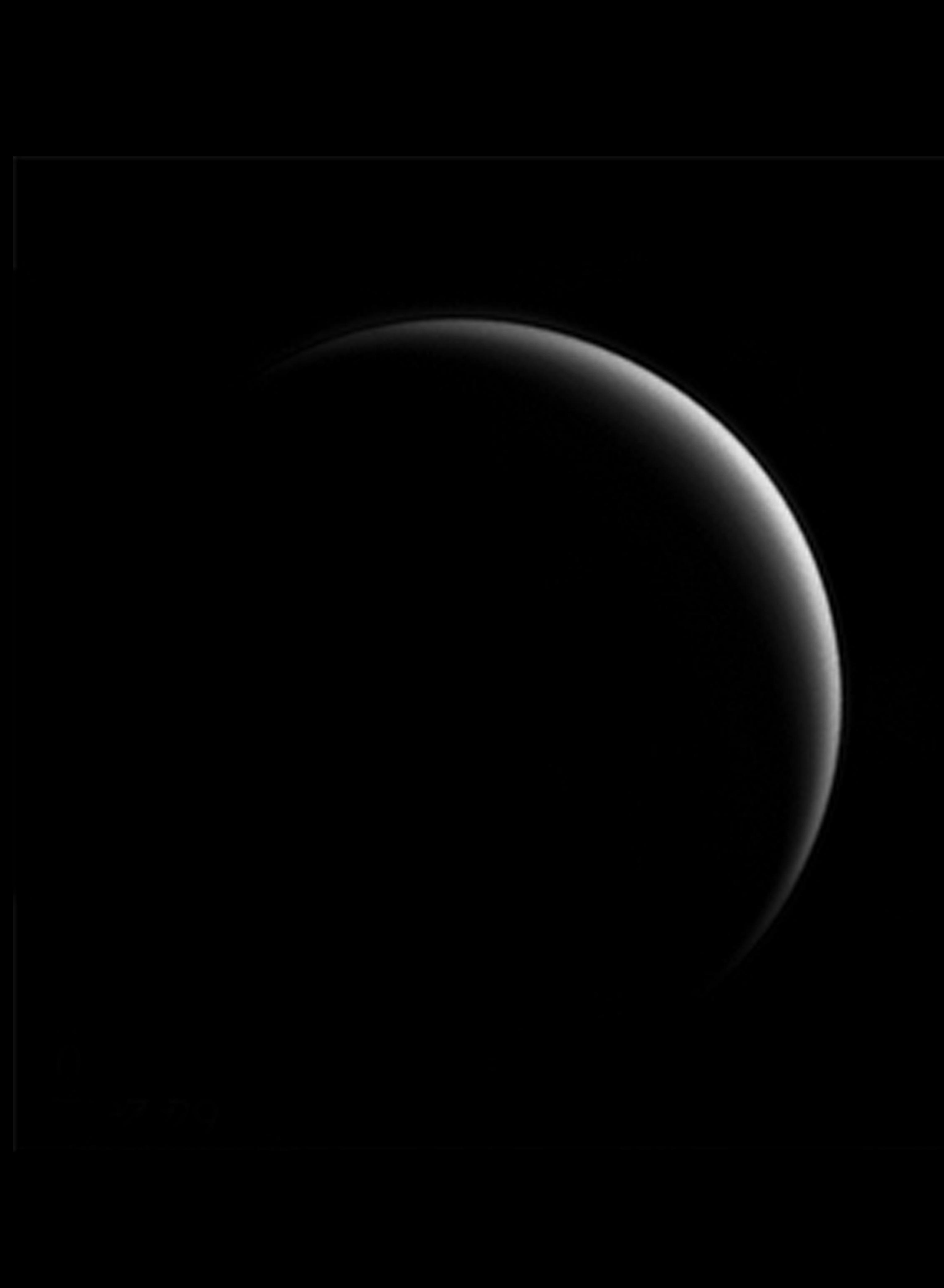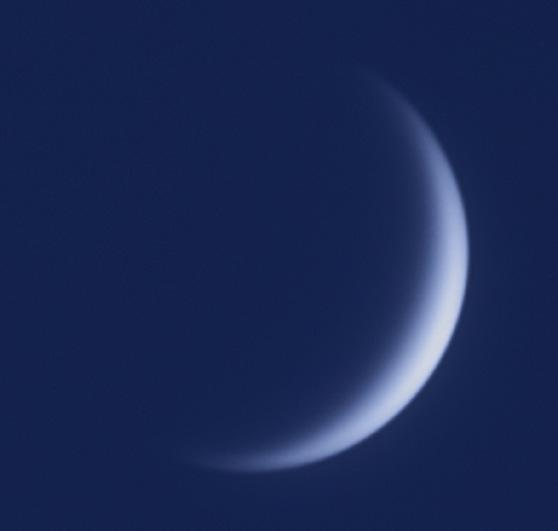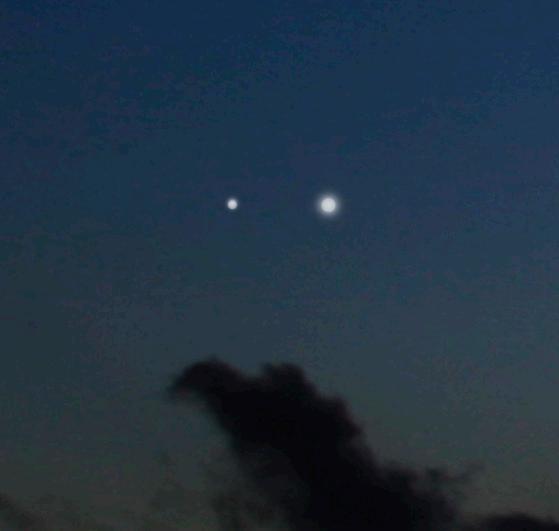
8 minute read
4 arcseconds across
The Sky Guide
MAY 2020
CRESCENT View Venus, well-positioned in the evening sky, in its beautiful crescent phases VENUSIAN

Watch Jupiter’s moon Callisto as it moves across the planet SHADOW TRANSIT
Observe a Mercury and Venus close approach IN CONJUNCTION
About the writers Astronomy expert Pete Lawrence is a skilled astro imager and a presenter on The Sky at Night monthly on BBC Four Steve Tonkin is a binocular observer. Find his tour of the best sights for both eyes on page 54
Also on view this month…
✦ Observe Comet C/2017 T2 PanSTARRS as it reaches peak brightness ✦ Three craters are visible bordering Mare Nectaris ✦ 42 Isis reaches opposition
Red light friendly
To preserve your night vision, this Sky Guide can be read using a red light under dark skies
Get the Sky Guide weekly For weekly updates on what to look out for in the night sky and more, sign up to our newsletter at www.skyat nightmagazine.com
Friday The dazzling evening planet Venus reaches its 25%-illuminated phase today. Venus can be seen shining in the evening twilight at mag. –4.5.
1
Wednesday Through the eyepiece, Venus currently appears as a 20%-lit crescent, 43 arcseconds across.
6

Tuesday A 74%-lit waning gibbous Moon appears near mag. –2.3 Jupiter and +0.8 Saturn as they rise above the southeast horizon at 02:30 BST (01:30 UT).
12

Today, Venus is rapidly increasing in apparent size, with 15%-illumination.
Friday Mercury and Venus appear just 0.9˚ apart around 11:00 BST (10:00 UT), during the day.
22

The evening view will be easier to find, with mag. –0.5 Mercury moving slightly to lie 1.3˚ from mag. –4.1 Venus.
Family stargazing It’s the final month that Venus will appear in the evening sky for the current period of visibility. This stunning planet will reach inferior conjunction on 3 June and from thereon in will return to the morning sky. This month, look for Venus every clear evening. Make sure the Sun has set first though. See how long you can follow it before it slips into the Sun’s glare. Then, next month, see how quickly you can recover it in the morning sky. It should be visible roughly 30 minutes before sunrise from mid-June onwards. www.bbc.co.uk/cbeebies/shows/stargazing
Wednesday This morning, the now 64%-lit waning gibbous Moon remains close to planets Jupiter and Saturn. Look for the trio at around 03:20 BST (02:20 UT) when they should be visible low above the southeast horizon.
13
Saturday This evening look out for a thin 1%-lit waxing crescent Moon near to mag. –0.3 Mercury and –4.2 Venus. Through a telescope Venus now appears as a 5%-lit crescent 54 arcseconds across. Mercury appears 65% lit and 6.4 arcseconds across.
23

Sunday Venus is now becoming a slender crescent through the eyepiece of a telescope, today appearing just 10% illuminated.
17
Sunday This evening a 4%-lit waxing crescent Moon lies near to mag. –0.3 Mercury and –4.2 Venus.
24
Comet C/2017 T2 PanSTARRS appears close to galaxies M81 and M82 in Ursa Major.
Wednesday This evening the 26%-lit Moon appears 2˚ to the east-northeast of the beautiful Beehive open cluster, M44.
27
Venus is now at 2% phase.
Saturday If you can catch a view of the Moon this afternoon through a telescope you should be able to make out the arc of light known as the Jewelled Handle. This occurs when the Jura mountain range around the edge of Sinus Iridum catches the early lunar dawn light.
2

Wednesday This morning there is a good opportunity to see the shadow of the outer Galiean moon Callisto transiting across Jupiter’s disc. The event starts at 01:30 BST (00:30 UT) and ends at 05:13 BST (04:13 UT).
20
Tuesday Noctilucent Cloud (NLC) season opens as we head towards the end of May. Last year gave some amazing displays. What will 2020 have in store?
26
Venus is now just 3%-illuminated.
Friday Three popular clair-obscur effects occur today. At 15:25 BST (14:25 UT) in daylight the Lunar X and Lunar V will be visible along the terminator. Then at 23:15 BST (22:15 UT), the Face in Albategnius effect will be visible.
29
Jewelled Handle

Thursday The annual Eta Aquariid meteor shower reaches its peak this morning. Although the shower has a peak Zenithal Hourly Rate (ZHR) of 28 meteors per hour, a low early morning radiant and full Moon in the sky will make this year’s display less than spectacular.
7
Thursday This morning it’s Ganymede’s shadow that can be seen in transit across Jupiter’s atmosphere. The transit starts at 03:40 BST (02:40 UT), mid-transit is at 05:28 BST (04:28 UT) and it ends at 06:55 BST (05:55 UT).
21


Saturday This evening it’s the turn of the weak Eta Lyrid meteor shower to reach its peak activity. Although the peak ZHR is only 3 meteors per hour, the shower does have a radiant which is high in UK skies. A bright Moon will interfere.
9

NEED TO
KNOW The terms and symbols used in The Sky Guide
Universal time (UT) and British Summer Time (BST) Universal Time (UT) is the standard time used by astronomers around the world. British Summer Time (BST) is one hour ahead of UT RA (Right ascension) and dec. (declination) These coordinates are the night sky’s equivalent of longitude and latitude, describing where an object is on the celestial ‘globe’
Family friendly Objects marked with this icon are perfect for showing to children
Naked eye Allow 20 minutes for your eyes to become dark-adapted
Photo opp Use a CCD, planetary camera or standard DSLR
Binoculars 10x50 recommended
Small/ medium scope Reflector/SCT under 6 inches, refractor under 4 inches
Large scope Reflector/SCT over 6 inches, refractor over 4 inches
Saturday This morning, at 02:00 BST (01:00 UT), Plato’s Hook makes its second appearance for the month. Turn to page 55 to find out more about it.
30
This evening it’s the turn of the clair-obscur effect known as the Eyes of Clavius.
GETTING STARTED IN ASTRONOMY If you’re new to astronomy, you’ll find two essential reads on our website. Visit http://bit. ly/10_easylessons for our 10-step guide to getting started and http://bit.ly/ buy_scope for advice on choosing a scope
1 Mar 1 5 Mar 27 Mar 15 Apr

24 Apr 15 May 20 May 25 May
Þ Evening glow: as Venus tracks across the sky from February to May, its apparent diameter grows and its phase shrinks
DON’T MISS
Heading towards INFERIOR CONJUNCTION VENUS
BEST TIME TO SEE: All month, easiest at the start of May
Brilliant Venus has been a dominant object in the western half of the sky following sunset for ages, but this month it’s all about to change. Venus is an inferior planet, meaning its orbit is smaller and closer to the Sun than that of Earth. From Earth we see Venus in different positions around its entire orbit. When it lines up with the Sun on the far side of that orbit, it’s in a position known as superior conjunction.
After this, Venus emerges from within the Sun’s glare into the evening sky where it’s been for the past few months. It takes a while to ‘get going’ from this point as it’s on the far side of its orbit from Earth.

Through a telescope after superior conjunction, the planet looks like a tiny gibbous Moon. As the days and weeks pass, Venus slowly moves closer to Earth. Its apparent diameter grows and its phase shrinks.
When the Earth –Sun–Venus angle reaches 90˚, we see the planet with a 50% phase, or thereabouts. An atmospheric phenomenon known as the Schröter effect, causes the 50% phase to appear a few days early in the evening sky. This point in Venus’s orbit was last reached on 27 March.
After this date Venus’s apparent size starts to grow rapidly as does the decrease in phase. At the start of May Venus shows a 39 arcsecond disc, 24% illuminated. However, by mid-month, the apparent diameter increases to 49 arcseconds with a phase dropping to 10%. This is a stunning sight if you can catch the planet through a telescope. The rapid increase in apparent size coupled with the rapid decrease in phase is due to the fact that Venus is swinging around the part of its orbit closest to Earth. It also means Venus isn’t far from lining up with the Sun on the
Earth side of its orbit, a position known as inferior conjunction. This next occurs on 3 June and represents the planet’s transition from the evening sky to the morning sky.
When Venus lines up with the Sun at inferior conjunction it typically passes north or south of the Sun’s disc in the sky. On rare occasions it appears to pass across the Sun’s face: a transit of Venus. The last of these occurred in 2012 and the next won’t happen until 2117. During the next inferior conjunction on 3 June, Venus passes half-a-degree north of the Sun’s centre, a condition which will place the planet just one-quarter of a degree from the Sun’s northern limb; sadly, too close to observe safely. Þ Enjoy it while it’s there – Venus is set to disappear from the evening sky towards the end of the month


